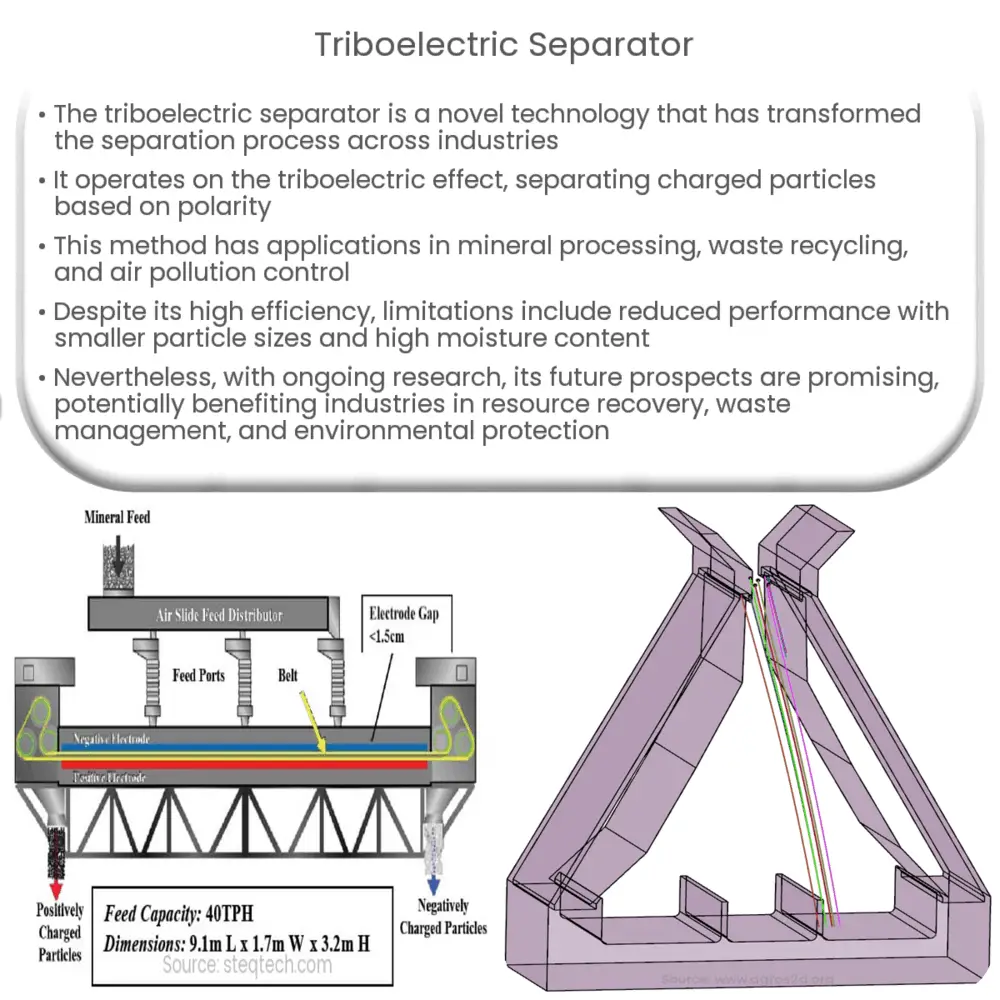Triboelectric separators use the triboelectric effect for efficient dry separation in industries like mineral processing and waste recycling.

Triboelectric Separator: Revolutionizing the Separation Process
Introduction
The triboelectric separator is an innovative technology that has transformed the separation process in various industries. This article will delve into the fundamentals of triboelectric separation, its applications, advantages, and limitations. We will also explore how this technology is revolutionizing the separation process and its potential impact on the future of various industries.
Understanding Triboelectric Separation
Triboelectric separation is a dry method that relies on the contact electrification between particles of different materials. This electrification process, known as the triboelectric effect, occurs when two materials come into contact and exchange electrical charges. When these charged particles are subjected to an external electric field, they separate according to their polarity.
The triboelectric separator consists of a belt conveyor, a vibrating feeder, and an electric field generator. The materials to be separated are fed onto the vibrating feeder, which disperses them onto the belt conveyor. As the particles come into contact with the belt, they become charged. The charged particles then enter the electric field, where they are separated based on their polarity and collected in separate containers.
Applications of Triboelectric Separation
Triboelectric separators have found numerous applications across various industries, including:
- Mineral processing: Triboelectric separators have proven to be highly efficient in the separation of minerals such as quartz, feldspar, calcite, and barite. They are also used in the beneficiation of phosphate rock and coal.
- Waste recycling: The technology has been successfully applied in the recycling of waste materials, including plastics, metals, and electronic waste. It helps in the recovery of valuable materials, reducing waste disposal and environmental impact.
- Air pollution control: Triboelectric separators have been employed in the removal of particulate matter from industrial flue gases, reducing emissions and mitigating air pollution.
Advantages of Triboelectric Separation
Triboelectric separators offer numerous benefits over conventional separation methods, such as:
- Efficiency: The technology provides high separation efficiency, enabling the recovery of valuable materials with minimal loss.
- Dry process: As a dry separation method, triboelectric separation eliminates the need for water, making it suitable for water-scarce regions and reducing the environmental impact of mining and recycling operations.
- Low energy consumption: Triboelectric separators consume significantly less energy compared to traditional separation methods, reducing operational costs and environmental impact.
- Versatility: The technology is adaptable and can be customized for specific applications and industries, providing a wide range of separation possibilities.
Limitations of Triboelectric Separation
Despite its advantages, triboelectric separation also has some limitations:
- Particle size: The efficiency of triboelectric separation decreases with smaller particle sizes, making it less suitable for fine materials.
- Moisture content: High moisture content in the feed material can negatively impact the separation efficiency, as it hinders the contact electrification process.
In conclusion, triboelectric separators have significantly transformed the separation process in various industries, offering numerous benefits over conventional
methods. However, it is crucial to consider the limitations of this technology when deciding on its application in specific industries.
Future Prospects of Triboelectric Separation
With continuous advancements in material science and engineering, the future of triboelectric separation technology looks promising. Researchers are working on overcoming its limitations and further enhancing its efficiency. Some potential developments in the field include:
- New materials: The development of novel materials with enhanced triboelectric properties could significantly improve the separation efficiency and broaden the range of applications for this technology.
- Improved particle charging: Advancements in the charging process may help overcome the limitations associated with particle size and moisture content, enabling the separation of fine and moist materials.
- Integration with other technologies: Combining triboelectric separation with other techniques, such as magnetic or electrostatic separation, could result in a more comprehensive and efficient separation process.
- Automation and control: The integration of advanced sensors and control systems could further optimize the separation process and improve operational efficiency.
Impact on Industries
As triboelectric separation technology continues to evolve, it is expected to have a significant impact on various industries:
- Resource recovery: Improved efficiency and versatility in the separation process can lead to higher recovery rates of valuable materials, reducing the depletion of natural resources and promoting sustainable practices.
- Waste management: Enhanced recycling capabilities can minimize waste generation, reduce landfill use, and mitigate the environmental impact of waste disposal.
- Environmental protection: The adoption of triboelectric separators in air pollution control can contribute to cleaner air, improving public health and the overall quality of life.
- Cost-effectiveness: Lower energy consumption and improved operational efficiency can lead to reduced operational costs for businesses, promoting the widespread adoption of this technology.
Conclusion
Triboelectric separation technology has revolutionized the separation process in various industries, offering numerous advantages over conventional methods. As research continues to advance this technology, it is expected to overcome its limitations and further enhance its efficiency, versatility, and environmental friendliness. As a result, triboelectric separators have the potential to significantly impact industries related to resource recovery, waste management, and environmental protection, contributing to a more sustainable future for all.

